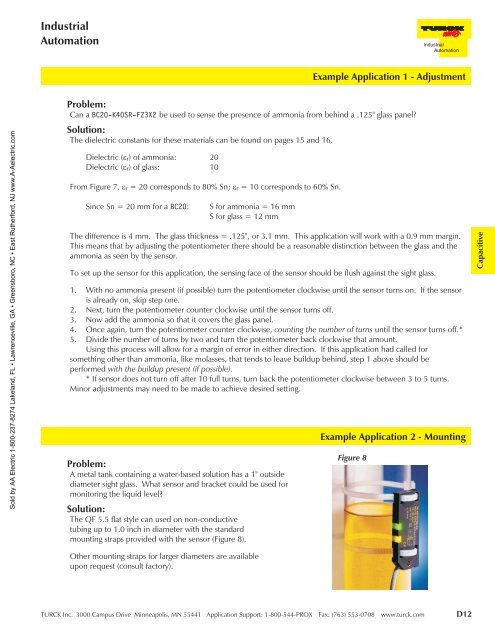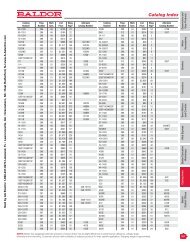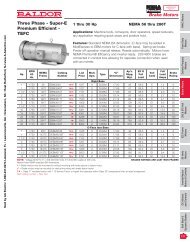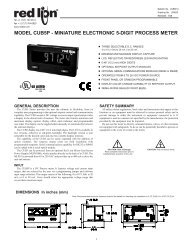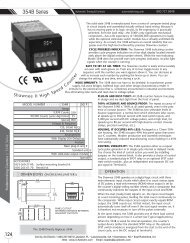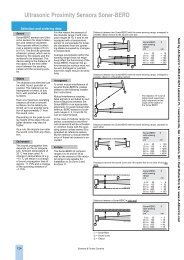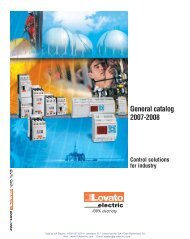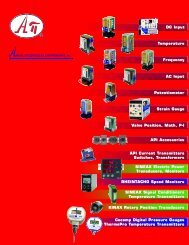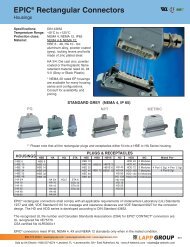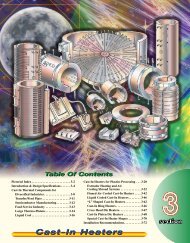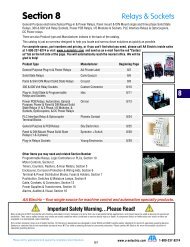- Page 2 and 3:
TURCK: Delivering Advanced Automati
- Page 4 and 5:
Kübler by TURCK Encoders • Incre
- Page 6 and 7:
often be made within several days.
- Page 8 and 9:
Introduction to Sensor Products In
- Page 10 and 11:
Sensor Quick Selection Guide Induct
- Page 12 and 13:
Cylinder Sensors Ultrasonic Sensors
- Page 14 and 15:
Selection Guide - Section L Introdu
- Page 16 and 17:
Axial Approach The approach of the
- Page 18 and 19:
eurofast ® Pinout Diagrams and Mat
- Page 20 and 21:
DC Outputs Two-, three-, or four-wi
- Page 22 and 23:
DC Outputs “AN4" and ”AP4" 3-Wi
- Page 24 and 25:
DC Outputs “LIU" 4-Wire Linear An
- Page 26 and 27:
AC and AC/DC Outputs Figure AC/DC O
- Page 28 and 29:
Series Connection Figure 4 Mechanic
- Page 30 and 31:
NAMUR (Y0 and Y1) Output NAMUR sens
- Page 32 and 33:
Third Party Compliances CSA - Canad
- Page 34 and 35:
Enclosure Ratings NEMA 250-1991 NEM
- Page 36 and 37:
Matrix of TURCK Sensor Materials *
- Page 38 and 39:
Notes: Sold by AA Electric 1-800-23
- Page 40 and 41:
Uprox ® Characteristics • No Cor
- Page 42 and 43:
Operating Distance (Sensing Range)
- Page 44 and 45:
2-Wire DC NAMUR Differential Travel
- Page 46 and 47:
2-Wire AC w/o Short-Circuit Protect
- Page 48 and 49:
4-Wire DC LIU Analog Ripple . . . .
- Page 50 and 51:
Notes: Sold by AA Electric 1-800-23
- Page 52 and 53:
Sold by AA Electric 1-800-237-8274
- Page 54 and 55:
Housing Style Part Number ID Number
- Page 56 and 57:
Housing Style Part Number ID Number
- Page 58 and 59:
Housing Style Part Number ID Number
- Page 60 and 61:
Housing Style Part Number ID Number
- Page 62 and 63:
Mounting TURCK inductive proximity
- Page 64 and 65:
Embeddable Mounting Characteristics
- Page 66 and 67:
Rectangular Sensor Selection Guide
- Page 68 and 69:
Inductive Sensor Part Number Key B
- Page 70 and 71:
Mounting Embeddable Mounting Charac
- Page 72 and 73:
Embeddable Mounting Characteristics
- Page 74 and 75:
Embeddable Mounting Characteristics
- Page 76 and 77:
Sensing Range Diagrams - Rectangula
- Page 78 and 79:
Housing Style - Rectangular Part Nu
- Page 80 and 81:
Housing Style - Rectangular Part Nu
- Page 82 and 83:
Housing Style - Rectangular Part Nu
- Page 84 and 85:
Housing Style - Rectangular Part Nu
- Page 86 and 87:
Housing Style - Rectangular Part Nu
- Page 88 and 89:
Housing Style - Rectangular Part Nu
- Page 90 and 91:
Housing Style - Rectangular Part Nu
- Page 92 and 93:
Housing Style - Rectangular Part Nu
- Page 94 and 95:
Housing Style - Rectangular Part Nu
- Page 96 and 97:
Housing Style - Rectangular Part Nu
- Page 98 and 99:
Housing Style - Rectangular Part Nu
- Page 100 and 101:
Housing Style - Rectangular Part Nu
- Page 102 and 103:
Housing Style - Rectangular Part Nu
- Page 104 and 105:
Housing Style - Rectangular Part Nu
- Page 106 and 107:
Housing Style - Rectangular Part Nu
- Page 108 and 109:
Housing Style - Rectangular Part Nu
- Page 110 and 111:
Housing Style - Rectangular Part Nu
- Page 112 and 113:
Housing Style - Rectangular Part Nu
- Page 114 and 115:
Housing Style - Rectangular Part Nu
- Page 116 and 117:
Housing Style - Rectangular Part Nu
- Page 118 and 119:
Housing Style - Rectangular Part Nu
- Page 120 and 121:
Housing Style - Rectangular Part Nu
- Page 122 and 123:
Housing Style - Rectangular Part Nu
- Page 124 and 125:
Housing Style - Rectangular Part Nu
- Page 126 and 127:
Housing Style - Rectangular Part Nu
- Page 128 and 129:
Housing Style - Rectangular Part Nu
- Page 130 and 131:
Housing Style - Rectangular Part Nu
- Page 132 and 133:
Inductive Barrel Sensor Selection G
- Page 134 and 135:
Inductive Barrel Sensor Selection G
- Page 136 and 137:
Inductive Sensor Part Number Key B
- Page 138 and 139:
Drill Hole Sizes for Metric Threads
- Page 140 and 141:
Embeddable Mounting Considerations
- Page 142 and 143:
Sensing Range Diagrams Axial Approa
- Page 144 and 145:
Housing Style Part Number ID Number
- Page 146 and 147:
Housing Style Part Number ID Number
- Page 148 and 149:
Housing Style Part Number ID Number
- Page 150 and 151:
Housing Style Part Number ID Number
- Page 152 and 153:
Housing Style Part Number ID Number
- Page 154 and 155:
Housing Style Part Number ID Number
- Page 156 and 157:
Housing Style Part Number ID Number
- Page 158 and 159:
Housing Style Part Number ID Number
- Page 160 and 161:
Housing Style Part Number ID Number
- Page 162 and 163:
Housing Style Part Number ID Number
- Page 164 and 165:
Housing Style Part Number ID Number
- Page 166 and 167:
Housing Style Part Number ID Number
- Page 168 and 169:
Housing Style Part Number ID Number
- Page 170 and 171:
Housing Style Part Number ID Number
- Page 172 and 173:
Housing Style Part Number ID Number
- Page 174 and 175:
Housing Style Part Number ID Number
- Page 176 and 177:
Housing Style Part Number ID Number
- Page 178 and 179:
Housing Style Part Number ID Number
- Page 180 and 181:
Housing Style Part Number ID Number
- Page 182 and 183:
Housing Style Part Number ID Number
- Page 184 and 185:
Housing Style Part Number ID Number
- Page 186 and 187:
Housing Style Part Number ID Number
- Page 188 and 189:
Housing Style Part Number ID Number
- Page 190 and 191:
Housing Style Part Number ID Number
- Page 192 and 193:
Housing Style Part Number ID Number
- Page 194 and 195:
Housing Style Part Number ID Number
- Page 196 and 197:
Housing Style Part Number ID Number
- Page 198 and 199:
Housing Style Part Number ID Number
- Page 200 and 201:
Housing Style Part Number ID Number
- Page 202 and 203:
Housing Style Part Number ID Number
- Page 204 and 205:
Housing Style Part Number ID Number
- Page 206 and 207:
Housing Style Part Number ID Number
- Page 208 and 209:
Housing Style Part Number ID Number
- Page 210 and 211:
Housing Style Part Number ID Number
- Page 212 and 213:
Housing Style Part Number ID Number
- Page 214 and 215:
Housing Style Part Number ID Number
- Page 216 and 217:
Housing Style Part Number ID Number
- Page 218 and 219:
Housing Style Part Number ID Number
- Page 220 and 221:
Housing Style Part Number ID Number
- Page 222 and 223:
Housing Style Part Number ID Number
- Page 224 and 225:
Housing Style Part Number ID Number
- Page 226 and 227:
Housing Style Part Number ID Number
- Page 228 and 229:
Housing Style Part Number ID Number
- Page 230 and 231:
Housing Style Part Number ID Number
- Page 232 and 233:
Housing Style Part Number ID Number
- Page 234 and 235:
Housing Style Part Number ID Number
- Page 236 and 237:
Housing Style Part Number ID Number
- Page 238 and 239:
Housing Style Part Number ID Number
- Page 240 and 241:
Housing Style Part Number ID Number
- Page 242 and 243:
Housing Style Part Number ID Number
- Page 244 and 245:
Housing Style Part Number ID Number
- Page 246 and 247:
Housing Style Part Number ID Number
- Page 248 and 249:
Housing Style Part Number ID Number
- Page 250 and 251:
Housing Style Part Number ID Number
- Page 252 and 253:
Housing Style Part Number ID Number
- Page 254 and 255:
Housing Style Part Number ID Number
- Page 256 and 257:
Housing Style Part Number ID Number
- Page 258 and 259:
Housing Style Part Number ID Number
- Page 260 and 261:
Housing Style Part Number ID Number
- Page 262 and 263:
Housing Style Part Number ID Number
- Page 264 and 265:
Housing Style Part Number ID Number
- Page 266 and 267:
Housing Style Part Number ID Number
- Page 268 and 269:
Housing Style Part Number ID Number
- Page 270 and 271:
Housing Style Part Number ID Number
- Page 272 and 273:
Housing Style Part Number ID Number
- Page 274 and 275:
Housing Style Part Number ID Number
- Page 276 and 277:
Housing Style Part Number ID Number
- Page 278 and 279:
Housing Style Part Number ID Number
- Page 280 and 281: Housing Style Part Number ID Number
- Page 282 and 283: Housing Style Part Number ID Number
- Page 284 and 285: Housing Style Part Number ID Number
- Page 286 and 287: Housing Style Part Number ID Number
- Page 288 and 289: Housing Style Part Number ID Number
- Page 290 and 291: Housing Style Part Number ID Number
- Page 292 and 293: Housing Style Part Number ID Number
- Page 294 and 295: Housing Style Part Number ID Number
- Page 296 and 297: Housing Style Part Number ID Number
- Page 298 and 299: Housing Style Part Number ID Number
- Page 300 and 301: Housing Style Part Number ID Number
- Page 302 and 303: Housing Style Part Number ID Number
- Page 304 and 305: Housing Style Part Number ID Number
- Page 306 and 307: Housing Style Part Number ID Number
- Page 308 and 309: Housing Style Part Number ID Number
- Page 310 and 311: Housing Style Part Number ID Number
- Page 312 and 313: Housing Style Part Number ID Number
- Page 314 and 315: Housing Style Part Number ID Number
- Page 316 and 317: Housing Style Part Number ID Number
- Page 318 and 319: Housing Style Part Number ID Number
- Page 320 and 321: Capacitive Sensor Selection Guide E
- Page 322 and 323: Sold by AA Electric 1-800-237-8274
- Page 324 and 325: Sold by AA Electric 1-800-237-8274
- Page 326 and 327: Capacitive Sensor Part Number Key B
- Page 328 and 329: Operating Principle Figure 2 Figure
- Page 332 and 333: Plastic Material Descriptions ABS -
- Page 334 and 335: Industrial Products and their Diele
- Page 336 and 337: Temperature and Environmental Condi
- Page 338 and 339: Housing Style Part Number ID Number
- Page 340 and 341: Housing Style Part Number ID Number
- Page 342 and 343: Capacitive Sensors - Rectangular Ho
- Page 344 and 345: Housing Style Part Number ID Featur
- Page 346 and 347: Capacitive Sensors - Rectangular Ho
- Page 348 and 349: Housing Style Part Number ID Number
- Page 350 and 351: Capacitive Sensors - Barrels Housin
- Page 352 and 353: Housing Style Part Number ID Number
- Page 354 and 355: Housing Style Part Number ID Number
- Page 356 and 357: Housing Style Part Number ID Number
- Page 358 and 359: Housing Style Part Number ID Number
- Page 360 and 361: Housing Style Part Number ID Number
- Page 362 and 363: Housing Style Part Number ID Number
- Page 364 and 365: Housing Style Part Number ID Number
- Page 366 and 367: Housing Style Part Number ID Number
- Page 368 and 369: Analog Sensor Selection Guide Embed
- Page 370 and 371: Analog Sensor Part Number Key B i 1
- Page 372 and 373: • Direct Actuation The highest ac
- Page 374 and 375: Housing Style Part Number ID Number
- Page 376 and 377: Linear Operating Distance (mm) Hous
- Page 378 and 379: Housing Style Part Number ID Number
- Page 380 and 381:
Housing Style Part Number ID Number
- Page 382 and 383:
Housing Style Part Number ID Number
- Page 384 and 385:
Housing Style Part Number ID Number
- Page 386 and 387:
Housing Style Part Number ID Number
- Page 388 and 389:
Housing Style Part Number ID Number
- Page 390 and 391:
Housing Style Part Number ID Number
- Page 392 and 393:
Linear Operating Distance (mm) Hous
- Page 394 and 395:
Sold by AA Electric 1-800-237-8274
- Page 396 and 397:
Sold by AA Electric 1-800-237-8274
- Page 398 and 399:
Sold by AA Electric 1-800-237-8274
- Page 400 and 401:
Cylinder Sensor Selection Guide Cyl
- Page 402 and 403:
B IM - A23 - A DZ 30 X2 Wiring Opti
- Page 404 and 405:
Cylinder Position Sensors “INT”
- Page 406 and 407:
CRS Inductive Sensors Figure 1 perm
- Page 408 and 409:
Drawing Manufacturer Cylinder Serie
- Page 410 and 411:
Drawing Manufacturer Cylinder Serie
- Page 412 and 413:
Inductive Cylinder Position Sensors
- Page 414 and 415:
Inductive Cylinder Position Sensors
- Page 416 and 417:
Inductive Cylinder Position Sensors
- Page 418 and 419:
Inductive Cylinder Position Sensors
- Page 420 and 421:
Inductive Cylinder Position Sensors
- Page 422 and 423:
Inductive Cylinder Position Sensors
- Page 424 and 425:
Inductive Cylinder Position Sensors
- Page 426 and 427:
Inductive Cylinder Position Sensors
- Page 428 and 429:
Inductive Cylinder Position Sensors
- Page 430 and 431:
Inductive Cylinder Position Sensors
- Page 432 and 433:
Inductive Cylinder Position Sensors
- Page 434 and 435:
Inductive Cylinder Position Sensors
- Page 436 and 437:
Inductive Cylinder Position Sensors
- Page 438 and 439:
Inductive Cylinder Position Sensors
- Page 440 and 441:
Inductive Cylinder Position Sensors
- Page 442 and 443:
Inductive Cylinder Position Sensors
- Page 444 and 445:
Inductive Cylinder Position Sensors
- Page 446 and 447:
Inductive Cylinder Position Sensors
- Page 448 and 449:
Inductive Cylinder Position Sensors
- Page 450 and 451:
Inductive Cylinder Position Sensors
- Page 452 and 453:
Inductive Cylinder Position Sensors
- Page 454 and 455:
Inductive Cylinder Position Sensors
- Page 456 and 457:
Inductive Cylinder Position Sensors
- Page 458 and 459:
Inductive Cylinder Position Sensors
- Page 460 and 461:
Ultrasonic Sensors Ultrasonic Senso
- Page 462 and 463:
Ultrasonic Sensors Ultrasonic Senso
- Page 464 and 465:
Ultrasonic Sensors Principle of Ope
- Page 466 and 467:
Ultrasonic Sensors Range adjustment
- Page 468 and 469:
Ultrasonic Sensors Housing Style Pa
- Page 470 and 471:
Ultrasonic Sensors Housing Style Pa
- Page 472 and 473:
Ultrasonic Sensors Housing Style Pa
- Page 474 and 475:
Ultrasonic Sensors Housing Style Pa
- Page 476 and 477:
Inductive Sensors Specialty Sensor
- Page 478 and 479:
Inductive Sensors B i 10 U - G T 30
- Page 480 and 481:
Inductive Sensors Housing Style Par
- Page 482 and 483:
Inductive Sensors Housing Style Par
- Page 484 and 485:
Inductive Sensors Housing Style Par
- Page 486 and 487:
Inductive Sensors Housing Style Par
- Page 488 and 489:
Inductive Sensors Housing Style Par
- Page 490 and 491:
Inductive Sensors Housing Style Par
- Page 492 and 493:
Inductive Sensors Valve Sensor Puck
- Page 494 and 495:
Inductive Sensors Valve Sensor Puck
- Page 496 and 497:
Inductive Sensors Housing Style Par
- Page 498 and 499:
Inductive Sensors Housing Style Par
- Page 500 and 501:
Inductive Sensors Housing Style Par
- Page 502 and 503:
Inductive Sensors Housing Style Par
- Page 504 and 505:
Inductive Sensors Housing Style Par
- Page 506 and 507:
Inductive Sensors Housing Style Par
- Page 508 and 509:
Inductive Sensors Housing Style Par
- Page 510 and 511:
Inductive Sensors Housing Style Par
- Page 512 and 513:
Sensors Mating Cordsets Cordset Sel
- Page 514 and 515:
Sensors Mating Cordsets eurofast ®
- Page 516 and 517:
Sensors Mating Cordsets minifast R
- Page 518 and 519:
Sensors Mating Cordsets 2-Pin eurof
- Page 520 and 521:
Sensors Mating Cordsets 4-Pin eurof
- Page 522 and 523:
Sensors Mating Cordsets 5-Pin eurof
- Page 524 and 525:
Sensors Mating Cordsets 3 and 4-Pin
- Page 526 and 527:
Sensors Mating Cordsets 3-Pin Appli
- Page 528 and 529:
Sensors Mating Cordsets 3 and 4-Pin
- Page 530 and 531:
Sensors Mating Cordsets 2 and 3-Pin
- Page 532 and 533:
Sensors Mating Cordsets 3-Pin minif
- Page 534 and 535:
Sensors Mating Cordsets 3-Pin micro
- Page 536 and 537:
Sensors Mating Cordsets 3 and 5-Pin
- Page 538 and 539:
Sensors Accessories Selection Guide
- Page 540 and 541:
Sensors Accessories Die Protector P
- Page 542 and 543:
Sensors Accessories Quick Mount Par
- Page 544 and 545:
Sensors Accessories Mounting Bracke
- Page 546 and 547:
Sensors Accessories Mounting Bracke
- Page 548 and 549:
Sensors Accessories Mounting Bracke
- Page 550 and 551:
Sensors Accessories Mounting Clamps
- Page 552 and 553:
Sensors Accessories Protective Hous
- Page 554 and 555:
Sensors Accessories firefast Connec
- Page 556 and 557:
Sensors Accessories Teflon Covers P
- Page 558 and 559:
Sensors Accessories Threaded Tank W
- Page 560 and 561:
Sensors Accessories Bolt-on Tank We
- Page 562 and 563:
Sensors Accessories Cable Glands Pa
- Page 564 and 565:
Sensors Accessories Plug Taps Part
- Page 566 and 567:
Sensors Reference Tables Selection
- Page 568 and 569:
Sensors Reference Tables Cable Diam
- Page 570 and 571:
Sensors Reference Tables Millimeter
- Page 572 and 573:
Sensors Index Index 1/2-14NPT . . .
- Page 574 and 575:
Sensors Index Index Bi 2-CRS705-AN4
- Page 576 and 577:
Sensors Index Index Bi 4-MT12HE-AP6
- Page 578 and 579:
Sensors Index Index Bi 8U-EM18WD-AP
- Page 580 and 581:
Sensors Index Index Bi15-Q20-Y0X .
- Page 582 and 583:
Sensors Index Index KB 4T-*/S90 . .
- Page 584 and 585:
Sensors Index Index Ni 5-G12-AP6X-V
- Page 586 and 587:
Sensors Index Index Ni14-M18-VN4X .
- Page 588 and 589:
Sensors Index Index Ni70U-Q80-VP4X2
- Page 590 and 591:
TURCK Innovative Solutions for Auto
- Page 592 and 593:
TURCK Innovative Solutions for Auto
- Page 594 and 595:
Sensors Index Warranty Terms and Co
- Page 596:
Sold by AA Electric 1-800-237-8274


